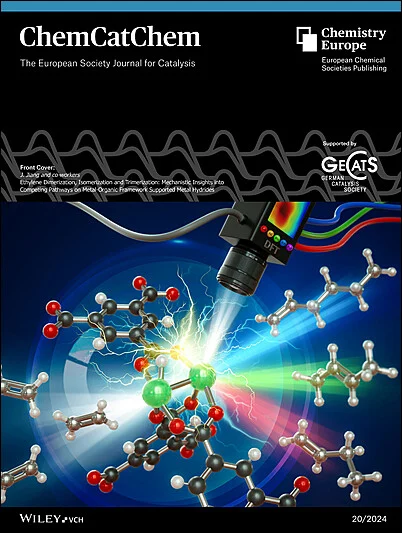Enhanced Catalytic Stability of Laccase Immobilized on Copper Oxide Nanoparticles
IF 3.8
3区 化学
Q2 CHEMISTRY, PHYSICAL
引用次数: 0
Abstract
We describe the design and catalytic activity of enzymatic nanoreactors based on copper oxide nanoparticles surface‐functionalized with laccase (CuO‐Lac) from Coriolopsis gallica. Transmission electron micrographs show complete laccase coverage on the nanoparticle surfaces. In addition, the catalytic rate (kcat) of the immobilized laccase is two‐fold higher at an optimized pH, when compared with free laccase, while the affinity constant (KM) is not significantly affected. Importantly, the total turnover number (TNN) of the CuO‐Lac nanoreactors reaches 358 ± 9 × 106 mol ABTS/mol laccase, which is four times higher than the TTN obtained for the free enzyme (88 ± 3 × 106). Thus, our nanoreactors exhibit a significant improvement in laccase catalytic performance. Inductively coupled plasma mass spectrometry was used to confirm the loss of copper ions from free laccase during the catalytic cycle, suggesting that the CuO nanoparticles act as a copper ion source that prevents enzyme inactivation. This work contributes to an improved understanding of the CuO‐laccase interface and confirms that CuO nanoparticles serve as copper sources for laccase during catalysis.增强固定在纳米氧化铜颗粒上的漆酶的催化稳定性
我们介绍了基于氧化铜纳米粒子的酶纳米反应器的设计和催化活性,该纳米粒子表面功能化了来自五倍子拟杆菌的漆酶(CuO-Lac)。透射电子显微镜照片显示,漆酶完全覆盖了纳米颗粒表面。此外,与游离漆酶相比,固定化漆酶在最佳 pH 值下的催化速率(kcat)高出两倍,而亲和力常数(KM)则没有受到明显影响。重要的是,CuO-Lac 纳米反应器的总周转次数(TNN)达到了 358 ± 9 × 106 mol ABTS/mol漆酶,是游离酶总周转次数(88 ± 3 × 106)的四倍。因此,我们的纳米反应器显著提高了漆酶的催化性能。电感耦合等离子体质谱法证实了在催化循环过程中游离漆酶中铜离子的流失,这表明 CuO 纳米粒子是防止酶失活的铜离子源。这项工作有助于加深对 CuO-漆酶界面的理解,并证实 CuO 纳米粒子在催化过程中是漆酶的铜离子源。
本文章由计算机程序翻译,如有差异,请以英文原文为准。
求助全文
约1分钟内获得全文
求助全文
来源期刊

ChemCatChem
化学-物理化学
CiteScore
8.10
自引率
4.40%
发文量
511
审稿时长
1.3 months
期刊介绍:
With an impact factor of 4.495 (2018), ChemCatChem is one of the premier journals in the field of catalysis. The journal provides primary research papers and critical secondary information on heterogeneous, homogeneous and bio- and nanocatalysis. The journal is well placed to strengthen cross-communication within between these communities. Its authors and readers come from academia, the chemical industry, and government laboratories across the world. It is published on behalf of Chemistry Europe, an association of 16 European chemical societies, and is supported by the German Catalysis Society.
 求助内容:
求助内容: 应助结果提醒方式:
应助结果提醒方式:


